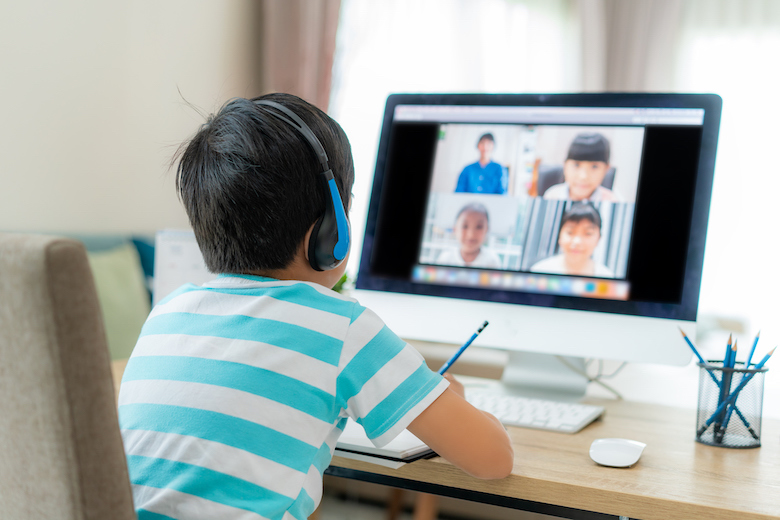After multiple delays in starting the new school semester due to the COVID-19 pandemic, South Korea has resumed school online. All students from Grade 1 to Grade 12 are now taking online classes. This unprecedented nation-wide program echoes a similar response in China, the pandemic’s ground zero, where a national remote learning program was launched on January 30.
As countries around the world continue to implement social distancing measures to slow the spread of COVID-19, it is increasingly likely that prolonged school closures, along with the remote learning programs they necessitate, will become the new normal. As schools across Canada continue exploring this uncharted territory of mass remote learning, experiences in China and South Korea, where educators have had to deal with problems such as technology access, content creation, and content delivery, may provide important insights on what to anticipate, avoid, and adopt.Problems such as technology access, content creation, and content delivery, may provide important insights on what to anticipate, avoid, and adopt. How can governments and school boards in Canada ensure relatively equitable access to educational resources, particularly online, and how can they facilitate and support teachers’ efforts to maintain educational standards and results?
Confronting the digital divide
The rapidly changing pandemic has laid bare digital divides that existed all along, and their effects on education are particularly devastating for students with limited or no internet access. In China, a country with vast regional inequalities, regional governments have mobilized telecom providers to boost internet connectivity – if only temporarily – for underserved families, particularly in rural areas. In South Korea, where cellular service reaches more of the population, the country’s ‘big three’ telecom companies have announced that they will waive data usage fees incurred while accessing online content from the Educational Broadcasting System (EBS), an educational broadcasting network that hosts the bulk of the country’s remote learning program.
Many students also lack smart devices appropriate for accessing educational content for long periods of time. In China, only 39.9 per cent of rural households have internet access through a computer. Officials have reported buying televisions with internet connectivity for some underprivileged families, though detailed statistics about coverage are unavailable. In South Korea, the Ministry of Education has made it clear that it has enough tablets and laptops in its possession to lend to the more than 220,000 students who lack them.
Economy of scale in content creation
Moving lessons online robs teachers and students of the interactions that make up a large part of the classroom experience, creating new hurdles for lesson planning, teaching, and evaluation. During the early stages of China’s online initiative and South Korea’s pilot programs, educators in both countries tried to record or live-stream their own lessons online, leading to high levels of stress and fatigue, particularly for those less familiar with the technology.
Policy-makers soon realized that it is almost impossible to ask teachers to simply migrate their classes online.Policy-makers soon realized that it is almost impossible to ask teachers to simply migrate their classes online. Two months after the beginning of remote learning, China’s Ministry of Education moved to ban local guidelines that forced teachers to prepare their own lessons and recommended utilizing existing video lessons on education portals such as the National Cloud Platform for Educational Resources and Public Service, recorded by teachers experienced with online learning. South Korea’s online program did a similar about-face. Though teachers in the pilot programs were asked to prioritize teaching through video conference, it is now expected that 90 per cent of classes will be based on pre-recorded lessons provided through the EBS, with notes and assignments uploaded by individual teachers to the same platform.
Staying connected
During a video session with teachers tasked with helping their colleagues improve their online teaching skills, South Korea’s Minister of Education experienced something sure to happen again later: the connection suddenly went dead. Connectivity issues are common in any remote setting, but they become particularly glaring when servers come under the pressure of millions of new users. Both the Chinese and Korean governments have announced plans to gradually scale up server capacities for major education portals. In the case of China, when such portals continued to experience lags, the Ministry of Education asked schools in different regions to log on at different times in order to lower internet traffic during peak hours. In both China and South Korea, government-backed education portals have moved to carry grade-specific programming through terrestrial, cable, and Internet Protocol TV, which serves to both cover more students and divert traffic to alternative channels of content delivery.

Experiences on the ground
Online education programs in China kept schooling going while students stayed at home to ‘flatten the curve.’ In South Korea, the plan is the same. For students, however, having classes online can not only be isolating but also physically exhausting: “My eyes became so tired at the end of the day,” complained one high-school student in China. “They couldn’t focus anymore.” This problem is especially acute for younger children, whose vision may still be developing. Learn-from-home arrangements in effect re-delegate the child-care function provided by schools to parents, creating additional hurdles for working parents with younger children, or children with special needs. Operating smart devices is also a concern, as one elementary school teacher in South Korea explained: “Many students in this area don’t have parents at home during the day, so even with the devices I’m worried that they won’t be able to operate them properly or stay focused.”
Lessons for Canada
The education systems in China and South Korea, which feature competitive, nation-wide standardized testing in addition to more centralization, are not the same as in Canada. But as school boards across Canada navigate the new reality of COVID-19, they face many of the same issues identified in China and South Korea: students without internet access or smart devices, stressed-out teachers scrambling to call their students and record their own video clips, and parents who are unable to provide sufficient supervision for children learning at home.
To the extent that some initiatives are already underway in Canada, efforts could be made to expand and standardize them to lessen disparities across schools.Experiences in China and South Korea show how some of those issues could be addressed. Ministries of education and school boards could partner with telecom companies to provide free internet or cellular data access to educational websites. They could also work with technical experts to create additional, high-quality video lessons, which could, in turn, be hosted on online portals with discussion and evaluation functionalities. Finally, schools could consider lending devices in their inventory to families in need. To the extent that some initiatives are already underway in Canada, efforts could be made to expand and standardize them to lessen disparities across schools.
As some students in China begin to go back to the classroom, and as students in South Korea begin their “first-in-history” online semester, it remains to be seen what type of new problems will surface and whether new solutions will emerge. For now, Canadian policy-makers and educators may find it useful to continue looking across the Pacific for insights.





